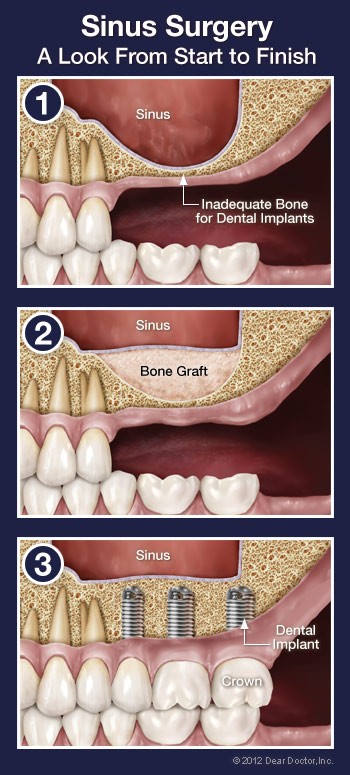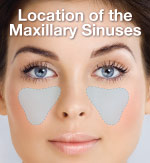If you want to replace a missing or failing tooth with a state-of-the-art dental implant (watch dental implant video) , your periodontist will first need to make sure that you have sufficient bone in your jaw to anchor the implant. This is true no matter what type of tooth is being replaced. However, if it is an upper back tooth and there is not enough bone under the gum where the implant needs to go, the base of the implant could end up poking through an air space (located to the side of the nose) called a sinus cavity. Since you can't anchor a dental implant to air, this presents a problem — but it is one that can often be solved with a minor in office surgical procedure called a “sinus augmentation".
 A sinus augmentation, or sinus membrane lift, involves adding bone to fill in the bottom of that air space, essentially raising the floor of the sinus cavity. Why wouldn't there be enough bone there already? For some people, it's simply a matter of how large their sinus cavities are, and their shape. In other cases, bone has actually been lost from the area. For example, if your tooth has been missing a long time, the bone that used to surround it may have begun to deteriorate. Bone in general needs stimulation to stay strong; in the case of the jawbone, that stimulation comes from the teeth. When teeth are lost, the bone loses stimulation and the body ceases to make new bone cells in that area. This leads to a reduction in bone volume and density. Also, if your tooth loss was due to periodontal (gum) disease, your tooth-supporting bone may have been reduced as a result of the disease. No matter what the reason is for insufficient bone, a sinus membrane lift can create more bone where it is needed.
A sinus augmentation, or sinus membrane lift, involves adding bone to fill in the bottom of that air space, essentially raising the floor of the sinus cavity. Why wouldn't there be enough bone there already? For some people, it's simply a matter of how large their sinus cavities are, and their shape. In other cases, bone has actually been lost from the area. For example, if your tooth has been missing a long time, the bone that used to surround it may have begun to deteriorate. Bone in general needs stimulation to stay strong; in the case of the jawbone, that stimulation comes from the teeth. When teeth are lost, the bone loses stimulation and the body ceases to make new bone cells in that area. This leads to a reduction in bone volume and density. Also, if your tooth loss was due to periodontal (gum) disease, your tooth-supporting bone may have been reduced as a result of the disease. No matter what the reason is for insufficient bone, a sinus membrane lift can create more bone where it is needed.
Where does this additional bone come from? It can be bone from elsewhere in your body, such as another part of your jaw or your hip. But most often, it will be bone grafting materials that are processed in a laboratory for these kinds of purposes. The original source may have been a human or animal donor (usually a cow). Synthetic products can also be used. All grafting materials must be approved by the Food and Drug Administration (FDA) and prepared according to their guidelines. The materials are specially treated to render them completely sterile, non-contagious, and free of rejection factors. For the most part, bone grafts act as scaffolds that the body will eventually replace with its own bone.
The Procedure
The surgical procedures are performed from inside the mouth in the area just above the missing back teeth. They are generally carried out under local anesthesia by numbing the area as is done for a routine filling. Some patients require addition sedation or anti-anxiety medication, which can be administered by mouth. These options should be discussed with your periodontist.
Sinus Osteotome Technique
If there is sufficient bone to stabilize an implant but not fully anchor it, a more minor sinus membrane lift can be done. This is achieved by accessing the sinus membrane directly through the site for implant placement and simultaneously placing the implant(s). It is performed using instruments called osteotomes (“osteo” – bone; “tome” – shaping) or specialized drills, which allow the sinus membrane to be very gently accessed and raised through the implant site. Once this is acheived a bone graft can then be placed in the sinus to further support the implant.
The Lateral Window Technique
If there is very little or no bone available, then a small window (about the length of two or three teeth) is created from within the mouth accessing the cheek-side bony wall of the sinus. This is known as a lateral (side) window technique. An opening is first made inside the mouth to expose the sinus wall. Next, a window is made in the bone to expose the sinus membrane, which is carefully and gently elevated in the area of the teeth to be replaced. The grafting materials are placed under the sinus membrane and the window is neatly closed. The grafted material is left to be covered by and/or converted into the body's own bone, a process taking six months or more before implants can be placed. If there is sufficient bone to stabilize the implants, they can be placed simultaneously with the bone graft, thus saving time and avoiding a second surgical procedure.

What to Expect After Sinus Surgery
There is usually no added soreness after a sinus membrane lift using the sinus osteotome technique procedure. But after a sinus augmentation using the lateral wall technique, you may experience moderate swelling and some minor discomfort that generally lasts a few days — about the same as having an upper impacted wisdom tooth removed. Sometimes a steroid or non-steroidal anti-inflammatory medication (prescription or over-the-counter) is recommended to help minimize this. A course of antibiotics may be prescribed to prevent infection. If the sinus membrane becomes a bit inflamed, leading to a feeling of minor congestion, a decongestant can be helpful.
Post-surgical care Instructions for Sinus Augmentation
RECOVERY
Rest with your head elevated when you arrive at home after the procedure. We ask that you please limit your physical activity and keep moving to a minimum for the first 24-hours.
ICE APPLICATION
For the first 4-5 hours after the surgery, we recommend placing an ice bag to your face in 20-minute intervals. This will help reduce facial swelling. If needed, you can use an ice bag for 24-hours. Your face will likely swell after surgery, so this is no cause for alarm. The ice and NSAID medication will both help alleviate the facial swelling.
MEDICATION INSTRUCTIONS
Please take anti-inflammatory medications (NSAIDs) to prevent inflammation, swelling, and pain. For the next 4-5 days, we suggest taking 400mg-800mg of Ibuprofen every six hours to reduce swelling and pain and quicken healing. DO NOT take more than 2400mg in a 24-hour period. If you experience excessive pain or discomfort, take the narcotic that has been prescribed to you. If you do not have one, please call our office and the doctor will call in a prescription to your pharmacy. Please take as directed along with the NSAID. If you’ve been prescribed an antibiotic, please take as directed. We ask that you finish the entire dosage. If any of the medications are causing you extreme nausea, itching, or a rash; discontinue its use and call our office immediately.
If you had surgery on your sinus, we ask that you please take an antihistamine as directed on the box for the first 4-5 days, especially if you are prone to feeling “stuffy” or sneezing. Be careful, due to the fact that an antihistamine can make you sleepy.
Please take your prescribed antibiotic as directed. We ask that you finish the entire dosage. If you notice that your pain or swelling are only increasing, or that you have a fever, please call our office immediately. We will be able to tell you if you have an infection.
IF YOU EXPERIENCE BLEEDING
Some minor oozing is expected for a few days after surgery and is no cause for alarm. If you see a lot of “red” in your mouth, it is likely a mixture of a little blood with your saliva. Blood can strongly “dye” and will tint your saliva red. You are likely not bleeding nearly as much as it seems. To stop the bleeding, apply pressure on the surgical site with a moistened piece of gauze or a tea bag for 20 minutes. If your bleeding is moderate to heavy and has continued for a few hours without stopping, please call our office immediately.
Sometimes patients have nosebleeds after sinus augmentation surgery. If this happens, lie down with your head elevated and place an ice bag to your nasal area. If your nosebleed continues longer than 30 minutes and will not stop, please call our office immediately.
EATING GUIDELINES
We ask that you do not try to eat until all the anesthesia has completely worn off. For the first week after surgery, we suggest eating high protein foods and liquids.
You may eat very soft foods if this can be done easily. Because your mouth will be sensitive, the food that you eat during the first week should be soft. Please DO NOT eat anything that is spicy, salty, acidic, very hot or very cold and please do not eat anything hard or crunchy, such as nuts, popcorn, chips, etc.
If possible, we also advise that you take the following nutritional supplements as they will aid in the healing process. Please take these vitamins for 4-6 weeks after surgery:
- Multi-vitamin with minerals (1/day)
- Calcium 500mg (twice/day)
- Vitamin E 400 iu (1/day)
- Vitamin C 1000mg (1/day)
CARING FOR YOUR MOUTH
We strongly request that you continue your regular oral hygiene habits on all other areas of your mouth. Please do not brush or floss the the surgical area during the first week after surgery as this will hinder the healing process. For the next month, please DO NOT use an irrigation tool, such as a WaterPik.
You can use an antiseptic mouthwash at least once in the morning and once at night before bed until your next appointment with our office. You can also gently swab the exposed surgical area with a cotton swab dipped in antiseptic mouthwash every morning, every night before bed and after eating and drinking.
WEARING YOUR REMOVABLE DENTAL APPLIANCE
If you have a removable appliance that replaces missing teeth and it touches your surgical area, please refrain from using this appliance as much as possible. We do not want any unneeded pressure on the surgical area as this could cause pain and hinder healing.
If you have any questions or concerns, please call our office at 847-658-3355.

